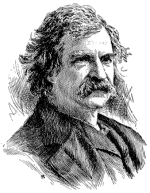The Boys’ Life of Mark Twain
by Paine

XLVII. The High-Tide of Fortune
That summer at Quarry Farm was one of the happiest they had ever known. Mark Twain, nearing fifty, was in the fullness of his manhood and in the brightest hour of his fortune. Susy, in her childish “biography,” begun at this time, gives us a picture of him. She begins:
“We are a happy family! We consist of Papa, Mama, Jean, Clara, and
me. It is Papa I am writing about, and I shall have no trouble in
not knowing what to say about him, as he is a very striking
character. Papa’s appearance has been described many times, but
very incorrectly; he has beautiful, curly, gray hair, not any too
thick or any too long, just right; a Roman nose, which greatly
improves the beauty of his features, kind blue eyes, and a small
mustache; he has a wonderfully shaped head and profile; he has a
very good figure–in short, is an extraordinarily fine-looking man.”
“He is a very good man, and a very funny one; he has got a temper,
but we all have in this family. He is the loveliest man I ever saw,
or ever hope to see, and oh, so absent-minded!”
We may believe this is a true picture of Mark Twain at fifty. He did not look young for his years, but he was still young in spirit and body. Susy tells how he blew bubbles for the children, filling them with tobacco smoke. Also, how he would play with the cats and come clear down from his study to see how a certain kitten was getting along.
Susy adds that “there are eleven cats at the farm now,” and tells of the day’s occupations, but the description is too long to quote. It reveals a beautiful, busy life.
Susy herself was a gentle, thoughtful, romantic child. One afternoon she discovered a wonderful tangle of vines and bushes, a still, shut-in corner not far from the study. She ran breathlessly to her aunt.
“Can I have it–can Clara and I have it all for our own?”
The petition was granted and the place was called Helen’s Bower, for they were reading “Thaddeus of Warsaw”, and the name appealed to Susy’s poetic fancy. Something happened to the “bower"–an unromantic workman mowed it down–but by this time there was a little house there which Mrs. Clemens had built, just for the children. It was a complete little cottage, when furnished. There was a porch in front, with comfortable chairs. Inside were also chairs, a table, dishes, shelves, a broom, even a stove–small, but practical. They called the little house “Ellerslie,” out of Grace Aguilar’s “Days of Robert Bruce.” There alone, or with their Langdon cousins, how many happy summers they played and dreamed away. Secluded by a hillside and happy trees, overlooking the hazy, distant town, it was a world apart–a corner of story-book land. When the end of the summer came its little owners went about bidding their treasures good-by, closing and kissing the gates of Ellerslie.
Looking back now, Mark Twain at fifty would seem to have been in his golden prime. His family was ideal–his surroundings idyllic. Favored by fortune, beloved by millions, honored now even in the highest places, what more had life to give? When November 30th brought his birthday, one of the great Brahmins, Dr. Oliver Wendell Holmes, wrote him a beautiful poem. Andrew Lang, England’s foremost critic, also sent verses, while letters poured in from all sides.
And Mark Twain realized his fortune and was disturbed by it. To a friend he said: “I am frightened at the proportions of my prosperity. It seems to me that whatever I touch turns to gold.”
 Continue...
Continue...![[Buy at Amazon]](http://images.amazon.com/images/P/B0006AHKG6.01.MZZZZZZZ.jpg)